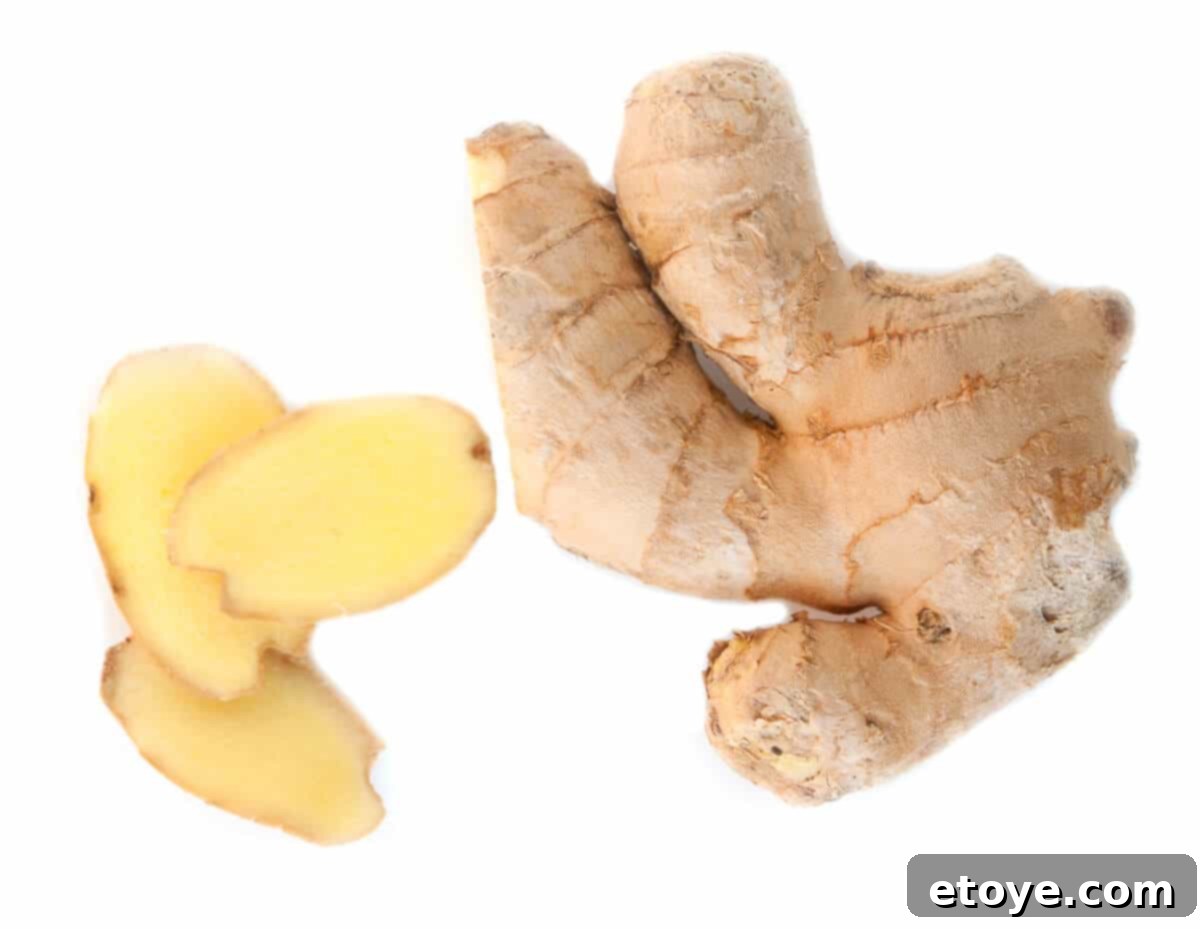
Mastering Leftover Ginger: Smart Preservation & Creative Culinary Uses
Ginger, with its unmistakable spicy, pungent, and aromatic essence, is a culinary staple in countless cuisines around the globe. From providing a zesty kick to vibrant stir-fries and fragrant curries, to offering a soothing warmth in teas and a refreshing note in desserts, its versatility is truly remarkable. Yet, despite its indispensable role, many home cooks often find themselves with a partially used knob of ginger, wondering how to best store it to maintain its freshness and potency. The common dilemma: how to prevent this valuable root from shriveling, molding, or losing its vibrant flavor before it can be fully utilized?
If you’ve ever gazed at a forgotten piece of ginger in your fridge, contemplating its fate, you’re not alone. The good news is that preventing food waste, especially with an ingredient as potent and beneficial as ginger, is easier than you might think. This comprehensive guide will transform your approach to leftover ginger, offering two highly effective preservation methods and a host of creative culinary ideas to ensure every inch of this magnificent root is put to good use. Embrace these tips and turn potential waste into a continuous source of delicious flavor and health benefits for your kitchen.
Why Ginger is a Culinary Powerhouse Worth Preserving
Before we delve into the practicalities of preservation, it’s worth highlighting the incredible value ginger brings beyond its taste. Revered for centuries in traditional medicine, ginger is a powerhouse of beneficial compounds. It’s widely recognized for its strong anti-inflammatory and antioxidant effects, which can help combat various ailments. Many turn to ginger for its digestive properties, finding relief from nausea, indigestion, and bloating. It can also help soothe muscle pain, lower blood sugar, and even support immune function. Given these health advantages, alongside its fantastic flavor, allowing any part of this root to go to waste feels like a missed opportunity. Let’s explore how to make the most of it!
Two Essential Strategies for Utilizing Leftover Ginger
Forget about the frustration of dried-out or spoiled ginger. These two proven methods will revolutionize how you manage your ginger supply, extending its shelf life and making it readily available for your culinary creations.
1. Infuse Your Cooking Wine with Ginger’s Zesty Essence
One of the most elegant and surprisingly simple ways to repurpose surplus ginger is by infusing it into your cooking wine. This technique not only grants the ginger an indefinite shelf life but also bestows a subtle yet distinctive layer of ginger aroma and flavor to your dishes. It’s particularly effective for enhancing the authenticity of Asian-inspired meals, where ginger is a cornerstone ingredient.
The Simple Process of Ginger Wine Infusion:
- Preparation is Key: Begin by thoroughly washing your piece of leftover ginger. While the skin is edible, peeling it can allow for a more potent infusion and a cleaner flavor profile. For peeling, skip the knife and grab a small spoon! The curved edge of a spoon is remarkably effective at scraping away the thin skin, neatly navigating the irregular contours of the ginger root and minimizing waste. Once peeled, thinly slice the ginger into rounds or julienne strips. The thinner the slices, the greater the surface area, which facilitates a faster and more robust flavor infusion into the wine.
- Selecting Your Wine Base: For truly authentic results, Chinese cooking wine (such as Shaoxing wine) is the traditional and highly recommended choice. Its complex, slightly nutty, and savory-sweet characteristics provide an ideal backdrop for ginger’s sharp notes. However, don’t hesitate to experiment! Dry sherry, sake, or even a good quality dry white wine like Sauvignon Blanc or Pinot Grigio can also work beautifully, offering slightly different flavor profiles suited to various cuisines. Always opt for a cooking wine that you wouldn’t mind drinking; the quality of the wine will directly impact the flavor of your infusion.
- Combining for Infusion: Carefully transfer the prepared ginger slices into a clean, airtight bottle. Then, pour your chosen cooking wine over the ginger, ensuring all the slices are completely submerged. This full submersion is crucial for proper infusion and preservation.
- Storage and Culinary Application: Seal the bottle tightly and store it in a cool, dark place, such as your pantry or a cupboard. The ginger will gradually release its vibrant flavors into the wine over time. While you’ll begin to notice the aromatic transformation within a few days, the flavor will deepen and become more complex over several weeks. The remarkable benefit of this method is its longevity: the alcohol content in the wine acts as a powerful natural preservative, meaning your ginger-infused cooking wine will remain fresh and flavorful virtually indefinitely.
This ginger-infused cooking wine is a versatile secret weapon for any home cook. A splash can elevate stir-fries, add depth to marinades for chicken, pork, or seafood, enrich braised dishes, and even form the base for sophisticated dipping sauces. Each use will impart that distinct, fresh ginger essence, enhancing the authenticity and complexity of your meals without the need for constant grating or chopping. It’s an effortless way to keep the vibrant taste of ginger on hand, ready to transform your everyday cooking into something extraordinary.

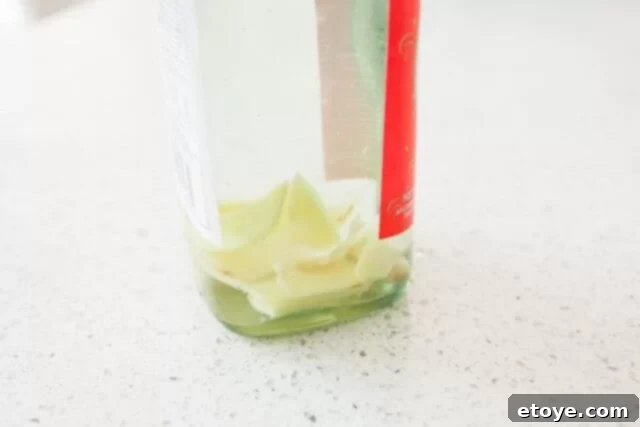
2. The Smart Way to Preserve Ginger: Freezing Grated Portions
While ginger-infused wine excels in liquid-based recipes, many dishes call for the full textural and aromatic impact of fresh ginger. Freezing offers an excellent long-term storage solution, but the common mistake of freezing a whole knob of ginger often leads to disappointment. When thawed, whole ginger tends to become brown, mushy, and significantly loses its vibrant flavor and potent aroma. The secret to successfully freezing ginger, ensuring it remains as fresh and effective as possible, lies in a crucial preparatory step: grating it first.
Key Advantages of Grating Ginger Before Freezing:
- Peak Freshness and Flavor Retention: Grating ginger before freezing helps preserve its bright yellow color, intense aroma, and pungent flavor far more effectively than simply freezing it whole. It locks in these qualities, ready for future use.
- Effortless Portion Control: By freezing ginger in a pliable roll, you create a system where you can easily break off or snap precisely the amount needed for any recipe. This eliminates guesswork, reduces waste, and saves time.
- Instant Usability: One of the greatest benefits is that frozen grated ginger can often be added directly to your hot dishes—soups, sauces, stir-fries—without the need for prior defrosting. It quickly melts and incorporates into your cooking.
- Eliminates Unpleasant Fibers: As we’ll detail below, the grating process, especially with a microplane, effectively separates the tough, stringy fibers from the flavorful pulp, resulting in a superior culinary experience.
Your Step-by-Step Guide to Freezing Grated Ginger:
Follow these detailed instructions to create a convenient, ready-to-use frozen ginger supply that will enhance your cooking for months.
Step 1: Master the Art of Efficient Ginger Peeling
Before any grating begins, the ginger root needs to be peeled. Forget about struggling with a vegetable peeler or a sharp knife on ginger’s irregular surface. Your best tool for this job is a simple kitchen spoon! The curved edge of a small spoon allows you to effortlessly scrape off the thin, papery skin, conforming perfectly to the root’s contours. This method is not only surprisingly effective and quick, but it also minimizes the waste of the precious, flavorful flesh underneath, making it far superior to traditional peeling methods. Simply hold the ginger firmly in one hand and use the spoon to gently scrape away the skin until the root is clean and smooth.

Step 2: Grate for Optimal Texture and Flavor Distribution
Once your ginger is peeled, it’s time to grate it. For this, a microplane grater is an absolutely indispensable tool. It far surpasses chopping ginger by hand, especially when it comes to consistency and flavor release. A microplane transforms ginger into an incredibly fine, almost paste-like consistency. This finely grated ginger “melts” seamlessly into your sauces, marinades, dressings, and stir-fries, ensuring that its robust flavor is evenly distributed throughout the entire dish. This means no more jarring surprises of biting into a large, poorly chopped piece of ginger, which can often be an unwelcome experience.
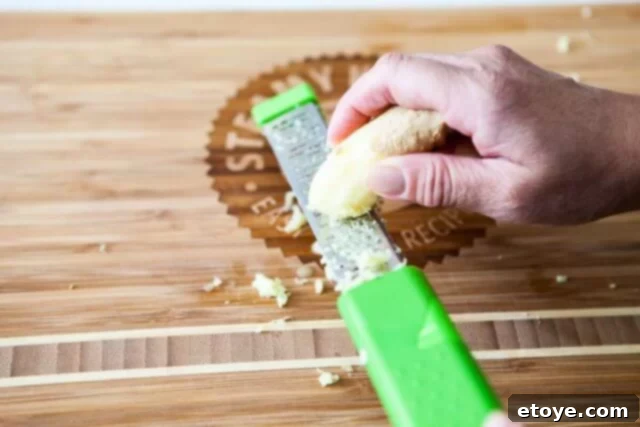
Step 3: The Game-Changing Benefit: Separating Tough Fibers
One of the most significant, yet often overlooked, advantages of using a microplane grater is its unique ability to separate the tough, stringy fibers of the ginger from its flavorful, tender pulp. As you glide the ginger across the microplane, the fine, aromatic ginger pulp easily passes through the tiny holes, while the coarse, often woody, and indigestible fibers are left behind on the grater’s surface. This ingenious separation ensures that you’re left with pure, smooth ginger paste, completely free of any annoying stringiness that can get stuck in your teeth or detract from the texture of your dish. This seemingly small detail dramatically elevates the overall eating experience of any recipe featuring ginger.


Step 4: Preparing for Freezing: The Convenient Roll Method
Once you have a fluffy mound of perfectly grated ginger, it’s time to prepare it for long-term storage in the freezer. Lay a piece of plastic wrap (cling film) flat on a clean counter surface. Using a spoon, carefully transfer the grated ginger onto the plastic wrap, arranging it into a relatively uniform, elongated line. Avoid spreading it too thinly; aim for a consistent thickness that will form a manageable roll.
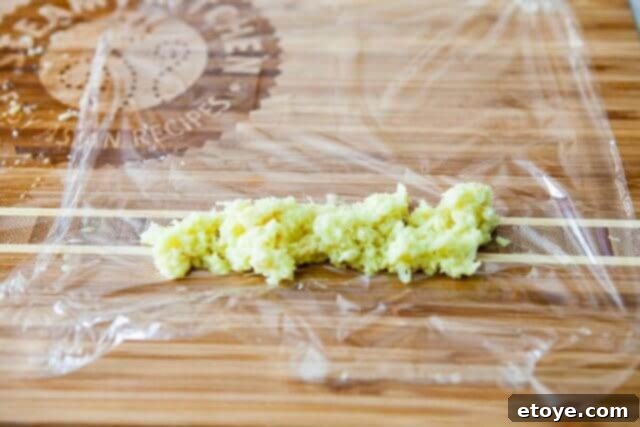
Step 5: Roll, Freeze, and Enjoy!
Carefully begin rolling up the plastic wrap, starting from one end, to tightly enclose the grated ginger. Form it into a compact cylinder, ideally about 3/4 inch (approximately 2 cm) in diameter. Ensure the plastic wrap is sealed as tightly as possible around the ginger to minimize air exposure and prevent freezer burn. The goal is to create a solid, yet pliable, roll that can be easily portioned.
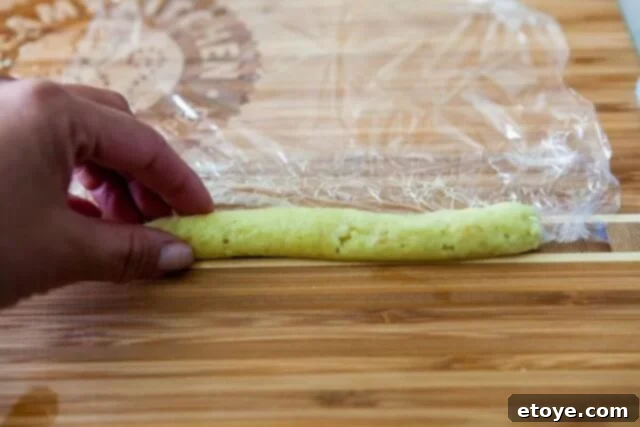

Place this ginger roll directly into your freezer. Once it’s frozen solid, you can transfer it to a more durable freezer-safe bag or container for added protection against freezer burn, which will help maintain its quality for several months. When your recipe calls for ginger, simply retrieve the frozen roll and snap off a small piece—or as much as you need! The ginger will remain beautifully bright yellow, full of its original, vibrant flavor, and perfectly ready to be added directly into your cooking. There’s no need to thaw it beforehand, saving you valuable time and effort in the kitchen. This ingenious method ensures you always have a supply of fresh-tasting ginger at your fingertips, eliminating the worry of spoilage and making spontaneous cooking a breeze.
Recommended Tools for Optimal Ginger Preparation
Having the right kitchen tools can significantly streamline the process of preparing and preserving ginger, making it a more enjoyable task. For achieving that ideal fine grate, a high-quality microplane is absolutely essential. These precision graters are designed to handle tough ingredients like ginger with ease, yielding perfect results every time. Here are two top-rated options that chefs and home cooks consistently praise:
- Kuhn Rikon Fine/Medium Grater: This grater is celebrated for its dual-sided design, typically offering both a fine and a medium grating surface. This versatility allows you to select the precise texture you desire for your ingredients. Kuhn Rikon products are known for their exceptional sharpness and robust durability, ensuring long-lasting performance in your kitchen.
- Microplane Classic Zester/Grater: Often considered the gold standard for zesting and fine grating, the Microplane brand is synonymous with incredibly sharp, photo-etched blades. This classic model makes quick work of ginger, citrus zest, hard cheeses, and more. Users frequently attest to its enduring sharpness and consistent, high-quality results, making it a valuable long-term investment for any kitchen.
Investing in a good microplane will not only simplify your ginger preparation tasks but will also noticeably enhance the texture and superior flavor distribution in all your dishes that call for this wonderful root.
Beyond the Basics: More Creative Uses for Your Leftover Ginger
While flavoring cooking wine and freezing grated ginger are fantastic long-term solutions, don’t overlook these other delightful ways to utilize smaller pieces or even the fibrous remnants of your ginger:
- Soothing Ginger Tea: A timeless classic! Slice a few pieces of fresh or frozen ginger, add them to a mug of hot water, and steep for 5-10 minutes. This creates a wonderfully warming, digestive, and immune-boosting tea. Enhance the flavor with a squeeze of lemon juice and a drizzle of honey.
- Homemade Ginger Syrup: Simmer ginger slices with equal parts sugar and water until the sugar dissolves and the liquid slightly thickens. Strain out the ginger (or leave it in for extra punch!). This versatile syrup is perfect for cocktails (like a Moscow Mule), homemade sodas, or drizzled over pancakes, waffles, and desserts.
- Sweet & Spicy Candied Ginger: Transform ginger into a delicious sweet treat. Simmer peeled ginger slices in a sugar syrup until tender, then allow them to dry slightly and roll them in granulated sugar. Candied ginger is excellent for snacking, adding to baked goods, or as a flavorful garnish.
- Aromatic Ginger Oil: Gently heat thinly sliced or roughly chopped ginger in a neutral-flavored oil (such as canola, grapeseed, or sunflower oil) over low heat until the ginger becomes fragrant and slightly crispy. Strain out the ginger and use the infused oil for stir-fries, dressings, or as a base for marinades.
- Nutrient-Packed Smoothie Booster: Add a small chunk of fresh or frozen grated ginger to your morning smoothie. It provides a refreshing spicy kick, helps cut through overly sweet fruits, and contributes a wealth of health benefits to your daily routine.
The Broader Impact: Why Reducing Food Waste Matters in Your Kitchen
Every effort you make to utilize ingredients like leftover ginger contributes to a much larger and critically important objective: reducing food waste. Globally, a staggering amount of food is discarded annually, leading to significant environmental burdens and economic losses. When food waste ends up in landfills, it decomposes and produces methane, a potent greenhouse gas contributing to climate change. Moreover, wasting food means wasting all the resources—water, energy, labor—that went into producing, processing, and transporting it.
By adopting smart preservation techniques, you’re not just saving money and adding flavor to your meals; you’re actively participating in a more sustainable approach to cooking and consumption. Ginger, being a fresh root, is particularly susceptible to spoilage if not stored correctly, making these preservation methods even more valuable. Embracing a “zero-waste” philosophy in your kitchen, even with small steps like using up leftover ginger, collectively makes a profound difference for both your household and the planet.
Conclusion: Embrace a Zero-Waste Ginger Philosophy
There’s no need to let valuable leftover ginger go to waste ever again. With the simple yet incredibly effective techniques of infusing cooking wine and freezing pre-grated portions, you can ensure that every bit of this remarkably versatile and healthy root is utilized to its fullest potential. These methods not only enhance your culinary prowess by making ginger readily available but also empower you to embrace a more sustainable and mindful approach to cooking.
So, the next time you find yourself with a surplus of ginger, remember these practical tips. Transform what might have been discarded into a convenient ingredient that consistently adds depth, zest, and a healthy boost to your dishes. Your taste buds, your wallet, and the planet will thank you!
